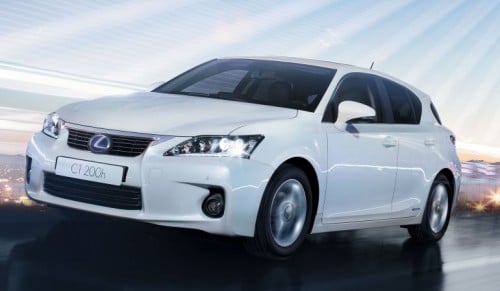
The most affordable Lexus in Malaysia was launched, with the full spec luxury version being priced at just under the RM200,000 mark. It’s not the only hybrid in the Lexus family but it’s the smallest model and represents the most affordable way to enter into Lexus ownership, which was previously held by the IS 250.
The Lexus CT 200h is built at the Toyota factory in Kyushu, Japan. For the Malaysian market, UMW Toyota Motor has introduced two variants – the Lexus CT 200h and Lexus CT 200h Luxury. Customers have a choice of 7 exterior colours, of which two – Fire Agate Mica Metallic and Flare Yellow Mica Metallic are available only with the Lexus CT 200h Luxury version.

Like the rest of the Lexus models, the CT 200h implements the latest adaptation of the L-finesse design philosophy. The front grille extends beyond the headlamps for greater visual integration with the bumper mid-section below. It incorporates a deeper, more sculpted interpretation of the L-finesse arrowhead motif. The CT 200h Luxury’s headlamps come with twin LED (light-emitting diodes) low beam lamps. In fact, the Lexus CT 200h has the largest number of external LEDs yet fitted to a Lexus model – 89 in total.
Incidentally, Lexus was the first car company to introduce LED headlamps for low beam usage, starting with the hybrid Lexus LS 600h L in 2007. LED headlamps consume almost 45% less power than conventional halogen units, thus they offer a small improvement in fuel economy. LEDs are also more lasting and illuminate more quickly.
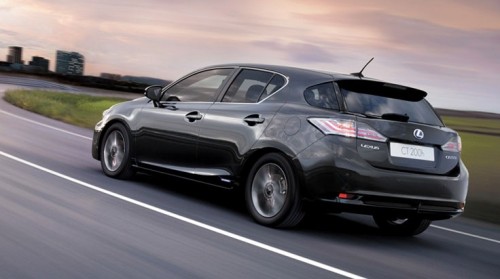
For the CT 200h Luxury, the pull-type front door handles have touch sensors to lock and unlock the doors. Lexus says the cut-out behind the handle is 3mm deeper than other Lexus models, a design improvement which is supposed to make for a more comfortable grip as people with big hands or long fingernails will be less likely to brush against the bodywork.
Diffuser fins under the centre of the car manage airflow as it moves towards the rear end. According to Lexus, departing airflow at the rear of the car is managed by the deep roof spoiler, aerodynamic fins at the corners of the rear windows and the sharp, near-vertical junction of rear wing and bumper. The underside has also been designed ensure the smoothest possible airflow.
Having a full hybrid powertrain means that the Lexus CT 200h can run in either petrol or electric modes exclusively, or a combination of both, unlike motor assist hybrids which have to depend on the combustion engine for drive all the time and can only use the motor for power assist whenever more power is needed.
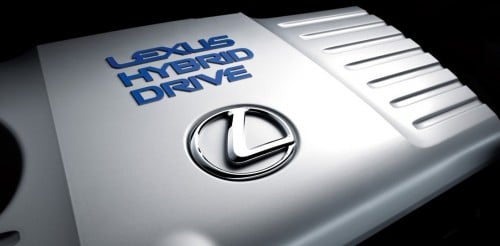
The Lexus Hybrid Drive in the Lexus CT 200h consists of a 1.8 litre 4-cylinder petrol engine, a powerful electric motor, a generator, a high-performance 168-cell battery, a power control unit and a power-split device. The electrical components are housed in a casing that is about the size of a conventional gearbox. Drive to the front wheels is through a Shift-by-Wire electronically-controlled continuously-variable transmission (E-CVT).
The DOHC 16-valve petrol engine has a capacity of 1.8 litres and develops 98 bhp at 5,200 rpm with 142 Nm of torque between 2,800 – 4,400 rpm. In combination with the output provided by the electric motor, the maximum power available can be boosted to 134 bhp. Torque from the electric motor is a maximum of 207 Nm and typical of electric motors, it peaks early so there is actually lots of torque from the get go. It’s nothing like a turbodiesel engine of course but the pull is stronger than a usual normally aspirated petrol engine.
The petrol engine, which has a high compression ratio of 13.0:1, is tuned for RON95 fuel. Factory tests based on Japan’s 10-15 cycle show the Lexus CT 200h to be capable of achieving up to 33 kms/litre.
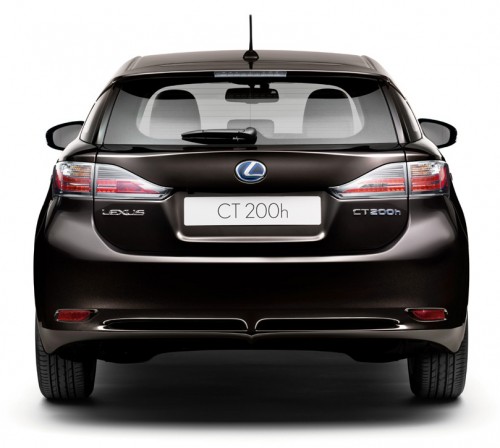
The hybrid system operates in various modes. Whenever the Lexus CT 200h is stopped for a while, the engine stops running to save fuel. It will automatically restart when moving off. Under certain conditions and with sufficient charge in the battery, the car can also run in EV mode, using only the electric motor. In this mode, emissions are zero and the car is remarkably silent while moving.
It’s actually quite a nice feeling driving a car that produces no sound other than a very soft electronic whine, and in the Prius which has the same system, I found myself forcing EV mode as often as I could in parking lots or as I was approaching my home. The maximum distance that can be travelled in EV mode is approximately 2 km, depending on speed and other factors that draw on battery power. When NORMAL mode is in use and from start-up to a maximum speed of 45 km/h, the CT 200h automatically runs in EV mode, unless battery power is low).
Other than the EV mode, there are also 3 other driving modes the driver can select – ECO, NORMAL or SPORT. ECO mode is used for fuel efficiency. Throttle response to aggressive inputs on the accelerator pedal is reduced and the air-conditioning operation is optimized for better fuel economy. Most people will find the ECO mode offers a more relaxed driving character with a better chance for the best fuel economy.
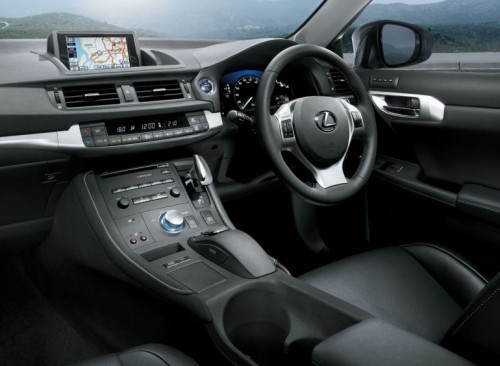
The SPORT mode increases the output of the electric motor. It not only modifies the throttle and EPS steering settings for better responsiveness but also reduces the influence of the Vehicle Stability Control (VSC) and Traction Control (TRC) systems.
Via the Electronically Controlled Braking Regeneration (ECB-R) system, the electric motor acts as a high-output generator during deceleration and also when braking. It recovers energy that would otherwise be lost and uses this energy as electrical energy for storage in the battery. The battery power level is constantly managed by the ECU and there is no need for recharging from an external source.
Introduced for the first time on a Lexus is a unique lateral performance damper system which absorbs and minimizes body vibrations for a more linear steering feel and better ride comfort. This system which available only with the CT 200h Luxury features a front performance damper connecting the left and right front suspension towers, and a rear damper connecting the left and right sides of the rear structural frame.
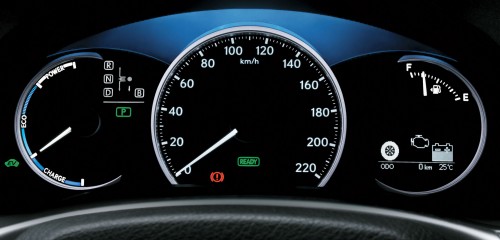
With construction similar to that of a monotube suspension damper, the front and rear assemblies differ according to the variations in body rigidity, noise and vibration of their surroundings, optimizing their ability to absorb body torsion, flexure and fine vibrations. According to Lexus, the result is reduced floor vibrations across a wide frequency range as well as reduced body flex in left and right front suspension tower displacement. Unsprung weight has been minimized and shock absorber damping response enhanced through the use of aluminium steering knuckles and stabilizer links, and lightweight lower arms, hub bearings and shock absorbers.
A lightweight, large diameter, front anti-sway bar improves the controllability, braking stability and evasive maneuverability of the car. It features a ball joint link strut connection for good sway rigidity, and a fluorine resin coating between the bushings and the bar itself reduces friction. A fully independent double wishbone rear suspension incorporates a lightweight trailing arm, and positions the coil spring and shock absorber separately to minimize system intrusion into the boot floor.
In order to minimize the yaw inertia moment and improve the CT 200h’s agility, bodywork components most distant from the vehicle’s centre of gravity – eg the bonnet, tailgate and bumper reinforcements – are made of lighter aluminium material. Overall vehicle height, ride height and the driver’s hip point have been set low while the hybrid battery has been located under the loadspace floor (but within the wheelbase), optimizing weight distribution and balance.
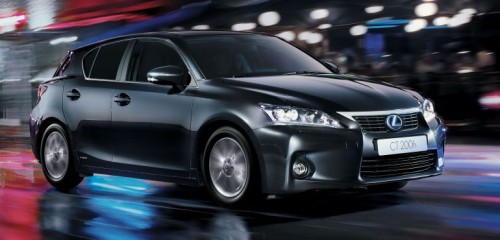
Standard wheels for the Lexus CT 200h are 16-inch aluminium alloy rims with 205/55R16 tyres. The spare tyre is a high-pressure emergency type.
The Lexus CT 200h has 8 airbags and Whiplash Injury Lessening (WIL) front seats are fitted as standard. There is also Anti-Lock brakes (ABS), Brake Assist (BA), Traction Control (TRC) and Vehicle Stability Control (VSC). TRC monitors and controls the amount of power that is applied to the road through the car’s wheels. If the system detects that one or more wheels is about to lose traction it instantly determines the best way to restore traction to that wheel, either by decreasing the power being sent to the wheel that is about to spin or, in more extreme cases, momentarily braking the wheel until it regains traction.
VSC is designed to help prevent loss of car control when entering a corner too fast or in slippery conditions which might lead to wheelspin. Via sensors monitoring car body rotation, wheel speed and brake pressure, the system assesses vehicle stability and a wheelslip situation. The system helps restore stability by applying calculated modulated braking to the appropriate wheel individually to create a counter-force. It works transparently and without any driver activation needed; when in operation, a warning light appears on the instrument panel to alert the driver.
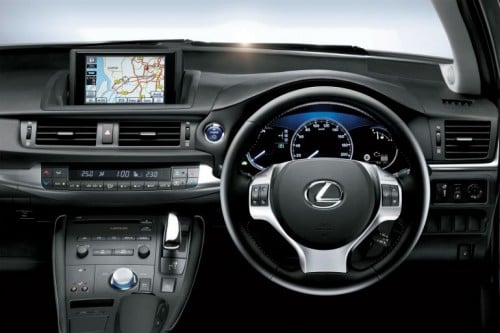
At the front, the CT 200h uses 10-inch ventilated disc brakes with aluminium calipers, a resin piston and high friction brake pads. Curiously, the rear discs are larger – 11-inch solid discs with aluminium calipers and a V-spring to reduce brake drag.
There are SRS dual-stage airbags at the front, side and also at the knees. The passenger’s airbag is larger than the driver’s and has a depression in the middle to ‘capture’ the occupant more effectively in the centre of the airbag so that load dispersal is optimized. Front occupants are also protected with curtain shield airbags.
There are 3 interior colour schemes – Black & Ivory (Lexus CT 200h Luxury only), all Black, or Black & Water Grey. The dashboard is divided into two distinct zones: an upper Display Zone, with an 7-inch LCD multi information display screen, and a lower Operation Zone, which has the shift lever and system controls.
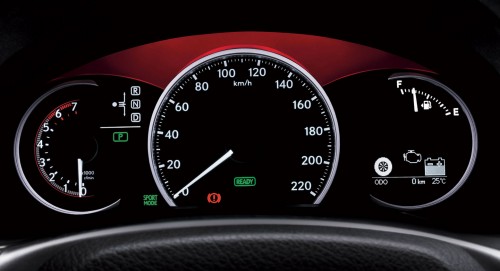
Selection of the ECO, NORMAL or SPORT mode is done using a rotating knob on the centre part of the dashboard. Depending on the mode selected, the illumination of the Optitron instrument panel will be either red (SPORT) or blue (ECO and NORMAL). In ECO and NORMAL modes, the leftmost meter will show a Hybrid System Indicator which keeps the driver informed of the output and regeneration status of the Lexus Hybrid Drive. The indicator also has an ECO zone to help the driver achieve lower fuel consumption. In SPORT mode, this display becomes a tachometer.
Both front and rear seat are placed close to the vehicle’s centre to reduce the polar moment of inertia and enhance maneuverability. The front seats are spaced at a distance of 71 cm, while rear seat spacing has been reduced to 62 cm and the hip point raised by 2.5 cm. The engineers also flattened the centre of the rear seats, thinned the front seatbacks and flattened the rear floor of the Lexus CT 200h’s platform.
The Luxury spec’s driver’s seat has an 8-way power adjustment and incorporates a memory function, power lumbar support adjustment. The front seats also have support wires inserted in the side bolsters. The front edge of the seat has been shaped to provide a larger contact area – Lexus claims this reduces fatigue on long journeys. There is also a support pleat on the cover to better coordinate the motion of the driver’s body with the car, giving a better sense of control.
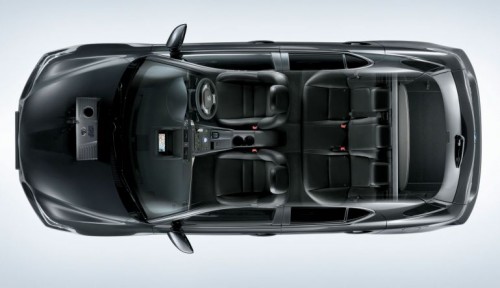
The hatchback has 375L of luggage capacity, and the floor is flat, extendable by folding down the rear backrests, increasing the volume to 985L. There is storage for two bottles and a can at the front and each door pocket can take a 500 ml bottle as well as a magazine. There is also a slot for a handphone between the front seats and a special handphone holder as well.
Unlike earlier hybrids, air-conditioning is not an issue as it is equipped with a system which uses a electric variable-capacity compressor. This type of compressor reduces the load on the engine, improving fuel economy. The compressor typically runs below full capacity enabling greater efficiency and lower noise levels. The air conditioner can continue to run even when the engine shuts off in EV mode. The Electric Power Steering (EPS) has a quick ratio of 14.6:1 and 2.7 turns lock-to-lock.
The Remote Touch multi-function control device (first offered in the RX 450h) is located directly in the operation zone directly behind the shift lever. It’s very different from the systems in other cars that typically uses rotary knobs, Lexus claims the Remote Touch operates on the same fundamental principles as a computer mouse, but adapted for use in the driving environment. The Remote Touch knob incorporates reaction force feedback for better tactility, and it offers control over the multi-display screen to access the audio, navigation, climate, phone and vehicle set-up systems.
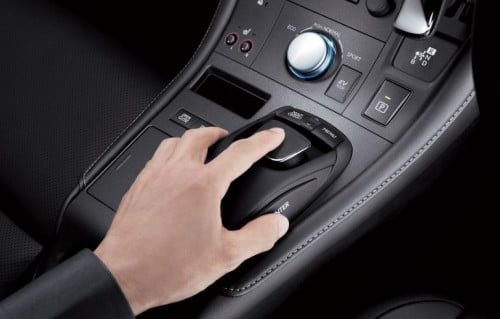
Interestingly Lexus has also tried to optimize the on-board audio system for better fuel economy. The speakers are unique, bamboo charcoal-based resin diaphragm speakers. Constructed using a complex compound combining bamboo charcoal, bamboo fibre and resin, the diaphragms are injection-moulded and are relatively thin. They are some 10 to 15% lighter than conventional speaker diaphragms, yet 20% stiffer and with a 10% greater sonic speed.
Fitted as standard in the Lexus CT 200h Luxury is a 10-speaker Lexus Premium Audio System, integrated with a 6-disc, in-dash CD-changer. The system uses a DSP integrated 8-channel, full-range class D amplifier. The new DSP unit, making its first appearance in a Lexus model, consumes 50% less power than a conventional, analogue-powered amplifier, and is also 26% lighter. This system has both USB and auxiliary port connectivity as well as Bluetooth mobile phone connectivity with an audio/video streaming function.
Enjoy a hi-res gallery of the Lexus CT 200h after the jump!
[zenphotopress number=999 album=2038]
Looking to sell your car? Sell it with Carro.













AI-generated Summary ✨
Comments on the Lexus CT 200h primarily highlight its status as an affordable Lexus hybrid with impressive features and quality, appreciated for its fuel efficiency, driving experience, and technological innovations. Many commenters express interest in test drives and admiration for the vehicle's sleek design and advanced tech, while some voice concern over maintenance costs, battery life, and the complexity of the system. There are also discussions about pricing, tax incentives, and comparisons with other vehicles like the Prius and Audi Q5, with some noting the value for money or premium feel. A few off-topic remarks about unrelated tech or off-topic comments are filtered out, but overall the sentiment is positive, emphasizing the CT 200h as a compelling, well-designed hybrid option within its price range.